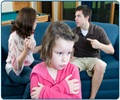US TV channels portray sex inside marriage negatively and promote promiscuity, says a study commissioned by the Parents Television Council.
US TV channels portray sex inside marriage negatively and promote promiscuity, says a study commissioned by the Parents Television Council.
Releasing the study, Happily Never After: How Hollywood Favors Adultery and Promiscuity Over Marital Intimacy on Prime Time Broadcast Television, council president Time Winter said, “Many in Hollywood are actively seeking to undermine marriage by consistently showing it in a negative manner. Even more troubling than the marginalization of marriage and glorification of non-marital sex on television is TV’s recent obsession with outré sexual expression. Children and teens are now exposed to a host of sexual behaviors that less than a generation ago would have been considered off-limits for broadcast television.”According to the PTC study, some of the once-taboo-for-TV sexual behaviors that are now found on prime time television include threesomes, partner swapping, pedophilia, necrophilia, bestiality, and sex with prostitutes, in addition to depictions of strippers, references to masturbation, pornography, sex toys, and kinky or fetishistic behaviors.
“Behaviors that were once seen as fringe, immoral, or socially destructive have been given the stamp of approval by the television industry. And recent studies show that children are influenced by those messages. Throughout much of the history of broadcast television, the networks adhered to a voluntary code of conduct which stipulated that respect should be maintained for the sanctity of marriage and the value of the home. Our report finds that not only are the boundaries no longer respected – they have been obliterated,” Winter said in a press release.
Among the points made in the study:
Although the networks shied away from talking about sex in the context of marriage, they did not shy away from discussions of masturbation, oral sex, anal sex, manual stimulation, sex toys, bondage or kinky or fetishistic sex – there were 74 such references during the study period.
The Family Hour – the time slot with the largest audience of young viewers where one might reasonably expect broadcasters to be more careful with the messages they are communicating to impressionable youngsters – contained the highest frequency of references to non-married sex. Family Hour references to non-marital sex outnumbered references to sex in marriage by a ratio of 3.9 to 1. During the 9:00 pm and 10:00 pm hours, the references to non-marital versus marital sex averaged 2.5 to 1.
Visual references to voyeurism (a third party present, watching or taping while sex takes place), transvestites/transsexuals, threesomes, kinky sex, bondage, sado-masochism, and prostitution outnumbered visual references to sex in marriage by a ratio of 2.7 to 1.
Content descriptors, which are intended to alert parents to inappropriate content and work in conjunction with the V-Chip to block such content that parents may find unsuitable for their children, were often lacking or inadequate.
Of all the networks, ABC had the most references to marital sex, but many of the references were negative. References to non-marital sex, by contrast, were almost universally positive or neutral.
In 46 hours of programming, NBC contained only one reference to marital sex, but 11 references to non-marital sex and one reference to adultery were made.
References to incest, pedophilia, partner swapping, prostitution, threesomes, transsexuals/transvestites, bestiality, and necrophilia combined outnumbered references to sex in marriage on NBC by a ratio of 27 to 1.
On NBC, there were as many depictions of adults having sex with minors as there were scenes implying or depicting sex between married partners.
Winter stressed, “Broadcasters, knowing television’s ability to influence behavior, must exercise greater responsibility when handling sexual situations during primetime hours – opting for less graphic visual content, and favoring storylines that don’t celebrate promiscuity, glamorize criminality, or denigrate monogamy. The American people need to hold the networks and their local broadcast affiliates accountable for pushing questionable content into their homes over the publicly-owned broadcast airwaves. In addition, advertisers need to reconsider their role as underwriters of such material, and whether they want to continue associating their brand names and hard-earned corporate images with salacious sexual content. While the Supreme Court awaits its next legal review of indecency on television, now is the time for families to raise their collective voice against the tide of graphic sexual content invading their homes.”
Michael Medved, Nationally Syndicated Talk Radio Host and PTC Advisory Board Member, warned. “For many years, parents have worried about television’s glamorization of destructive sexual behavior. This important new report suggests another cause for concern: the de-glamorization of marriage. Statistics show that the overwhelming majority of Americans feel satisfied and fulfilled by their marriages. The notion that sex outside of marriage is inherently more exciting, more important, more worthy as the subject of story-telling, is a toxic message for parents and children alike.”
Source-Medindia
GPL












